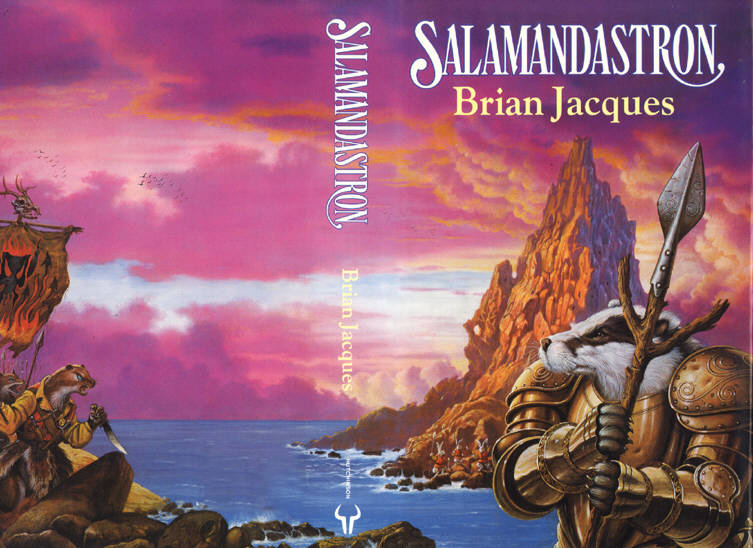 |
| Lord Brocktree |
I grew up not only learning about badgers from my animal books but I read about them in a different capacity, through fiction I was enlightened. Throughout my childhood I read the Tales of Redwall books, written by the late Brian Jacques. It was a world where the majestic badger lords and ladies ruled the mountain kingdom of Salamandastron. They were the mightiest of warriors, the fairest rulers and the most respected of creatures. From Lord Brocktree to Lady Cregga Rose Eyes you could always rely on the badgers to protect their friends and dispatch their foe with unparallelled strength, along with The Long Patrol, their loyal army of Hares. These are the sorts of stories and tales which really captured my imagination, the stories they told were of a warriors code, destiny, duty, unity, friendship and villainy (some of them were really dark looking back on it) & subliminally they opened my eyes to the brilliant wildlife we can find in the United Kingdom. They resonate even today. Its safe to say I am very passionate about the badger, they rank highly and I, like many others do strive to help protect these creatures from the encroaching unjust, cruel and nonsensical threats poised against them by certain sectors of our society and government. Threats that are equally as poisonous and brutal without cause as some of the enemies I grew up reading about in the Redwall books.

 |
| Badger footprint |
 |
| Peanut butter with red pellets |
This reminiscing leads nicely into something our group at university has just started doing. We are helping to take part in some badger surveying around our universities estate. Its something I've always wanted to do, we have been told of the theory a million times but to actually go out and put some of the theory to use is superb! The setts had already been identified our role was to help with some bait marking surveys (not to be confused with the medieval badger baiting). First of all we walked around the areas of the setts identifying signs of presence, including footprints, snuffle holes and walkways. The next task was to find the latrines, these are originally snuffle holes in the ground which the badger then proceeds to use as a toilet, as a method of marking out their territory. Once we had found some (I never thought we'd be so happy to find poo) we could move onto the bait marking. This involved mixing a small amount of tiny (and I mean tiny, probably 2mm max) coloured plastic pellets in with a dollop of jam or peanut butter. We spaced these out around the setts ranges under heavy logs or stones. The reason for jam or peanut butter, well badgers like a lot of animals have an irresistible sweet tooth. Placing the bait under heavy logs or stones is also ideal as badgers are incredibly strong, with massive front paws. They will be easy for them to tip over to get to the bait whilst preventing other mammals such as foxes from getting to it. We used different coloured pellets for different setts. Once this was done it was time to retreat, the next stage begins tomorrow... early. We will have to revisit the latrines and look through the faeces (who said working with animals is glamorous). The pellets would have been digested and expelled as part of the faeces meaning that we can identify which coloured pellets are in which latrine, thus allowing us to mark out the territory for that particular sett (as they will leave some droppings in a number of latrines around the sett). It'll be a great way of helping us map out the local territories for our resident badgers, after all anything that can help us further understand them must be a good thing.
 |
| Snuffle holes |
 |
| Badger pathway |
The Results
Round 2
Another week, another round of surveying. The pellets had been reset over the weekend and our group were in to check the latrines once more. Again it was a bit of a mixed week, in some places we found pellets in others, nothing. Its slightly frustrating but something you have to deal with, adapt and try again, after all this is a survey that overall could take years to get conclusive results from. Alongside searching latrines we did move the process further slightly. This week our main focus was classification of the setts, along with marking territory it is important that we understand which setts are which in a territory, whether they are the main sett, annexe setts subsidiary or outliers, this is vital information which becomes useful when mitigation arises, as it is more important to concentrate efforts on the main and annexe setts rather than outliers which are rarely used.
 |
| Latrine with faeces |
 |
| Outlying sett |
Unfortunately this was the last week we were out with the badgers, Time to leave it to the professionals. I know we could have stayed for the rest of the year working on this, i wouldn't have complained that's for sure, but our timetable says otherwise. We still have plenty of lectures that we can't afford to not have, as this conservation stream is the only part of the course I have an exam in this year.
So this ends my contribution with the wonder that is the badger, for now at least. I've thouroughly enjoyed it.
Birdman





.JPG)
.JPG)
.JPG)




No comments:
Post a Comment